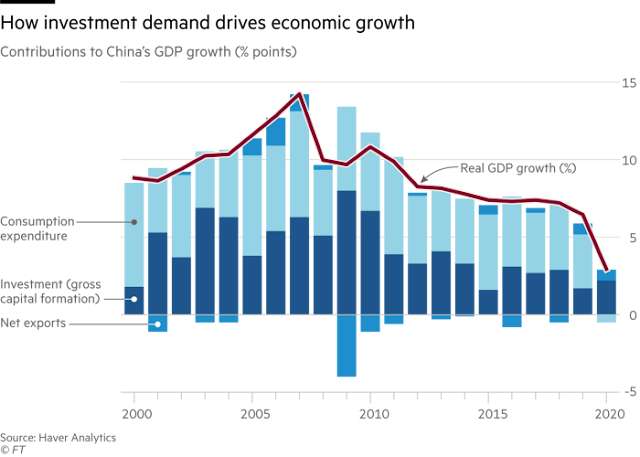My investment idea have been resonated with an article written by Martin Wolf, this guy of Economics sphere is a big one, please read and store as follows
From the macroeconomic point of view, the most important fact
about the Chinese economy is its extraordinary savings. In 2010, gross national
savings reached 50 per cent of gross domestic product. Since then, it has
fallen a little. But it was still 44 per cent of GDP in 2019. While household
savings are extremely high, averaging 38 per cent of disposable incomes between
2010 and 2019, they account for slightly less than half of all these savings.
The rest consist mainly of corporate retained earnings. Investment plus net
exports have to match savings when the economy is operating close to potential
output, if it is not to fall into a slump. Since the global financial crisis, net exports have been a small share of
GDP: the world would not accept any more. Total fixed investment duly
averaged about 43 per cent of GDP from 2010 to 2019. Surprisingly, this was 5
percentage points higher than between 2000 and 2010. Meanwhile, growth fell
significantly. This combination of higher investment with lower growth indicates a
big fall in the returns on investment

Yet there are even bigger problems than
this suggests. One is that the high investment is
associated with huge increases in debt, especially of households and the
non-financial corporate sector: the former jumped from 26 to 61 % of GDP
between the first quarters of 2010 and 2021 and the latter from 118 to 159 %.
Another is that a substantial part of this investment has been wasted. Xi
Jinping himself has spoken of the need to shift “to pursuing genuine rather than
inflated GDP growth”. This has to be a big part of what he meant. This
combination of high and unproductive investment with soaring debt is closely
related to the size and rapid growth of the property sector. A 2020 paper by
Kenneth Rogoff and Yuanchen Yang argues that china's property sector contributed 29 % of GDP in 2016. Among high-income economies,
only pre-2009 Spain matched this level. Moreover, almost 80 percent of this
impact came from investment, while about a third of China’s exceptionally high
investment has been in property
A number of
powerful indicators show that this investment is driven by unsustainable prices
and excessive leverage, and is also creating huge excess capacity: the price to
income ratios in Beijing, Shanghai and Shenzhen are far
higher than in other big cities around the world; housing wealth accounted for
78 per cent of all Chinese assets in 2017, against 35 per cent in the US;
household debt ratios are comparable with those in high-income countries; vacancy rates and other measures of excess capacity are high;
and rates of home ownership had reached 93 per cent in 2017. Furthermore, family formation is slowing, China’s population is aging and
60 % of it is already urbanised. All these signal that the property boom must
end.
Since the
government controls the Chinese financial system, it can prevent a financial
crisis. A large fall in house prices and a big negative
impact on household wealth and spending are likely, but might be
avoided. The likeliest threat is that investment in
property will collapse. This would have a large negative effect on local
government finances. But, above all, it would leave a huge hole in
demand. Rogoff and Yang argue that “a 20 % fall in real estate activity could
lead to a 5-10 per cent fall in GDP, even without amplification from a banking
crisis, or accounting for the importance of real estate as collateral.” It
could be worse.

Between 2012 and 2019,
investment contributed 40% of China’s growth in demand. If investment in
property fell sharply, it would leave a huge shortfall. Yet tolerating this
painful adjustment would ultimately be desirable.
It should improve the welfare of the population: after all, building unneeded
properties is a waste of resources. Slowing the
recent pace of property investment would also be a natural consequence of the
“three red lines” for property developers imposed by the state last year: hard
limits on a company’s debt-to-asset ratio, its debt-to-equity ratio and its
cash-to-short-term-debt ratio. The main policy
now should be to shift spending towards consumption, and away from the most
wasteful investment. This would require redistribution of income towards
households, especially poorer households, as well as a rise in public
consumption. Such a shift would also fit with the recent attack on
the privileges of great wealth. It would also require big reforms, notably in
taxation and the structure of public spending. In addition, investors should be
shifted away from property toward the transition away from high carbon
emissions. That too would require big policy changes.
Crises are also
opportunities. The Chinese government is well
aware that the great investment boom in property has gone far beyond reasonable
limits. The economy needs different drivers of demand. Since the
country is still relatively poor, a prolonged economic slowdown, such as
Japan’s, is unnecessary, especially when one considers the room for improved
quality of growth. But the model based on wasteful investment has reached its
end. It must be replaced



